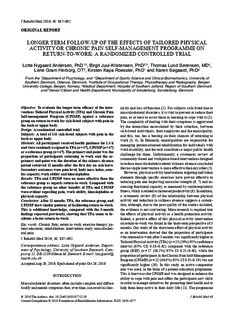| dc.contributor.author | Andersen, Lotte Nygaard | |
| dc.contributor.author | Juul-Kristensen, Birgit | |
| dc.contributor.author | Sørensen, Thomas Lund | |
| dc.contributor.author | Herborg, Lene Gram | |
| dc.contributor.author | Roessler, Kirsten Kaya | |
| dc.contributor.author | Søgaard, Karen | |
| dc.coverage.spatial | Denmark, Sønderborg | nb_NO |
| dc.date.accessioned | 2019-04-12T08:15:18Z | |
| dc.date.available | 2019-04-12T08:15:18Z | |
| dc.date.created | 2017-02-07T13:41:00Z | |
| dc.date.issued | 2016 | |
| dc.identifier.citation | Andersen, L., Juul-Kristensen, B., Sørensen, T., Herborg, L., Roessler, K., & Søgaard, K. (2016). Longer term follow-up on effects of Tailored Physical Activity or Chronic Pain Self-Management Programme on return-to-work: A randomized controlled trial. Journal of Rehabilitation Medicine, 48, 887-892 | nb_NO |
| dc.identifier.issn | 1650-1977 | |
| dc.identifier.uri | http://hdl.handle.net/11250/2594401 | |
| dc.description.abstract | Objective: To evaluate the longer term efficacy of the interventions Tailored Physical Activity (TPA) and Chronic Pain Self-management Program (CPSMP) against a reference group on return-to-work for sick-listed subjects with pain in the back or upper body.
Design: A randomized controlled trial.
Subjects: A total of 141 sick-listed subjects with pain in the back or upper body.
Methods: All participants received health guidance for 1.5 h and were randomly assigned to TPA (n = 47), CPSMP (n = 47) or a reference group (n = 47). The primary end-point was the proportion of participants returning to work and the co-primary end-point was the duration of the sickness absence period retrieved 11 months after the first day on sick leave. Secondary outcomes were pain level, body mass index, aerobic capacity, work ability and kinesiophobia.
Results: TPA and CPSMP were no more effective than the reference group as regards return-to-work. Compared with the reference group no other benefits of TPA and CPSMP were evident regarding pain, work ability, kinesiophobia or physical capacity.
Conclusion: After 11 months TPA, the reference group, and CPSMP show similar patterns of facilitating return-to-work. This is additional knowledge, compared with the 3-month findings reported previously, showing that TPA seems to facilitate a faster return-to-work. | nb_NO |
| dc.language.iso | eng | nb_NO |
| dc.publisher | Foundation for Rehabilitation Information | nb_NO |
| dc.rights | Navngivelse-Ikkekommersiell 4.0 Internasjonal | * |
| dc.rights.uri | http://creativecommons.org/licenses/by-nc/4.0/deed.no | * |
| dc.title | Longer term follow-up of the effects of tailored physical activity or chronic pain self-management Programme on return-To-work: A randomized controlled trial | nb_NO |
| dc.type | Journal article | nb_NO |
| dc.type | Peer reviewed | nb_NO |
| dc.description.version | publishedVersion | nb_NO |
| dc.rights.holder | © 2016 The Authors | nb_NO |
| dc.subject.nsi | VDP::Medisinske Fag: 700::Helsefag: 800::Fysioterapi: 807 | nb_NO |
| dc.source.pagenumber | 887-892 | nb_NO |
| dc.source.volume | 48 | nb_NO |
| dc.source.journal | Journal of Rehabilitation Medicine | nb_NO |
| dc.source.issue | 10 | nb_NO |
| dc.identifier.doi | 10.2340/16501977-2159 | |
| dc.identifier.cristin | 1447868 | |
| cristin.unitcode | 203,3,11,0 | |
| cristin.unitname | Institutt for ergo/fysio/radio - Bergen | |
| cristin.ispublished | true | |
| cristin.fulltext | original | |
| cristin.qualitycode | 1 | |

